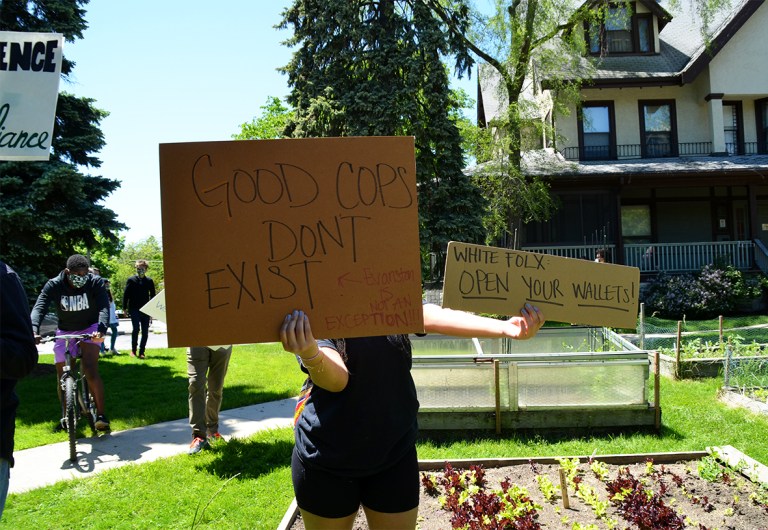Though photographers reserve the right to take pictures of protesters in public, The Daily has chosen to not publish images that could easily reveal the identities of those who are depicted.
The photo gallery is viewable at the bottom of this post.
On Sunday, thousands of people gathered for a youth-organized, socially distant march for Black lives in Evanston, Illinois. Evanston is a suburb directly bordering Chicago, and is often praised for its diversity. However, the need for the march and the speeches shared shed light on a side of Evanston that is not as eagerly shared as sound bites about diversity. The following photographs capture a march of people coming together, bearing masks and signs, to express outrage and galvanize action.
Evanston likes to think itself a place of diversity. That’s the narrative I grew up with, the story I saw around me at the public high school, and the sound bite I’ve shared with those who are unfamiliar with my hometown.
The crowd I marched alongside on Sunday seemed to match that description. I saw folks of every age, race, gender and religion, walking together to show a common outrage. It felt unifying, everyone fighting together for our city and our country.
But the speeches at the end of the march opened my eyes to something else. Standing in the parking lot of Evanston Township High School, a building whose four miles of hallways I had walked just last year, I understood more than ever before that my Evanston isn’t Evanston.
My Evanston doesn’t arrest me for riding on the back of a bike, unlike the 12-year-old brother of one young Black woman who shared her story in a rally speech at the march. My Evanston doesn’t come into my childhood home and tackle me after I’ve said, “Please don’t touch me or I’ll have a panic attack,” unlike the experience of another young Black man. My Evanston doesn’t pull me over and question me for no reason eight times a month, unlike the Black son of a woman who spoke. My Evanston doesn’t do these things to me because I’m a white upper middle class woman. My Evanston shouldn’t be so different.
I knew Evanston was segregated from housing to lunch tables to advanced classes, and I knew racism existed within its borders. I knew there had been incidents, and I had read articles and had class discussions. But I had been so sheltered. Sheltered by socioeconomically stratified AP classes and predominantly white neighborhoods and private Jewish middle school and white skin.
I’ve never been pulled over, never had any run-ins with the police. None of my friends have either. I knew my experience wasn’t universal, but I had no idea how different it was from the experiences of so many in Evanston. I fell into the false security of thinking that things weren’t that bad here in Evanston, that the problems might exist but not to the same extent here.
It shouldn’t be that way. I never should have been so unaware. How could I have graduated from a school like Evanston Township High School, a school so focused on racial justice, and never have known of these experiences happening just outside my line of sight? How could I have emerged from Evanston so blind to the nature of where I came from?
When I got home, my dad asked if I thought the demonstration had been a success. Before this, I was never sure if the success of protests is measured more by proving a point in the face of unjust systems, or in unifying and firing up the people trying to dismantle those institutions.
The marches and demonstrations and riots of late have proved a point, and the unity and speeches I felt and heard were equal parts heartbreaking and inspiring. Everyone left with a fire, or at least sparks.
But I told my dad I don’t know yet. The success of the demonstration depends on if we can keep that flame burning when we’re not physically marching together, when we’re not united by chants, when the marching path isn’t already carved out for us. The purpose of a rally is what happens next.
As the final speaker pointed out, “I just ask you to support, and do more than just show up. This is nice, this is Evanston. But Evanston needs more than that. We absolutely need to be the community that we all claim we are.”
Hearing those speeches, those stories — many from people I went to high school with, graduated with, but never even knew — forced me away from equating my Evanston with Evanston. Hearing those stories personified the difference between my America and America as a whole.
America too needs to do more than show up. America too needs to be the country it claims to be.
Look through these photos, scroll through the gallery, but don’t stop there. Seeing is the first step, but it isn’t enough. Engage in hard conversations. Examine your subconscious biases. Call your representatives and donate to organizations fighting to make a difference. Demand justice with your words and your time and your pocketbook.
I have a lot of work to do, in struggling with the conflict that in many ways I have been complicit in, the conflict of my city and of my country. There are a lot of difficult conversations I need to force myself to engage with and a lot of ways in which I need to study my privilege. I need to push myself out of my comfort zone, because I have rested comfortably in it for too long.
It’s on all of us to be the people we claim to be.
Contact Sarah Bloom at snbloom ‘at’ stanford.edu.
[ubergrid id= 1168873]
